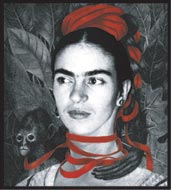 “Frida Kahlo, Diego Rivera and 20th Century Mexican Art” is a vibrant and compelling exhibit that is currently at the Mexican Fine Arts Museum in Pilsen, on Chicago’s South Side.
“Frida Kahlo, Diego Rivera and 20th Century Mexican Art” is a vibrant and compelling exhibit that is currently at the Mexican Fine Arts Museum in Pilsen, on Chicago’s South Side.
This is the largest and most high profile exhibit ever at that museum; it is also one of their best.
There has been renewed interest in Kahlo and Rivera because of “Frida,” the recent film on her life. The movie has a shot at earning Oscar nominations for the lead performances by Salma Hayek (as Kahlo) and Alfred Molina (as Rivera).
The art in the exhibit is very varied, and there is no one dominant style that is represented. However, a number of the pieces combine surrealism and/or cubism with indigenous and Mexican themes.
Kahlo never considered herself to be a part of the surrealist movement, and she once said, ” I never knew I was a surrealist until {the French poet} Andre Breton came to Mexico and told me I was one.”
The exhibit features paintings and sketches by some of the most important 20th century Mexican artists including Frida Kahlo and the muralist/painter Diego Rivera. There are approximately 125 pieces in all including 9 by Rivera and 15 pieces by Kahlo.
One of the most striking pieces is Kahlo’s “Self Portrait with Monkeys (1943)” which presents Frida as an earth mother/nature goddess figure surrounded by cute black monkeys. According to thecityreview.com, Diego once gave Frida, a monkey as a substitute for the child she could never have.
Kahlo’s “Diego on My Mind ‘ is equally impressive. It features the artist in the guise of a blooming white flower. Since habit-like white petals surround her, she also looks like a nun. . It has a little picture of Diego on the head to capture their interconnectedness. The piece is a touching love poem to the love of her life.
The exhibit does not include any of Rivera’s trademark murals which often included subversive anti-capitalist content, but it does include some paintings that depict street scenes like the ones in the murals.
“Calla Lily Vendor” and “Sunflowers,” are two large paintings, which celebrate peasant life and nature. Rivera did both paintings in 1943, and they are major works in the artist’s oeuvre
There are also several pieces that try to capture Rivera’s essence. It is interesting to contrast the handsome portrait of him by Frida Kahlo (1937) with the obese, clownish and cartoon-like one done by Miquel Covarrubias.
Also fascinating was Rufino Tamayo’s “Portrait of Cantinflas (1948),” which features the great silent comedian depicted in a style reminiscent of Picasso’s cubist works. The museum is scheduled to show some of his comedy classics on March 29th and 30.
There is one major reservation about the exhibit. All of the works come from the private collection of the Gellmans, a married couple that collected art.
The collection represents their own tastes and biases, and the Gellmans tended to prefer straightforward portraits to overtly political and extremely experimental art.
Also there are no pieces, which reflect Kahlo’s great psychological and physical turmoil and agony. Some of the best pieces by Diego and Kahlo are not in the collection.
But what is here is very high quality. The exhibit is not quite as fascinating as the Remedios Varo exhibit I saw at the Mexican Fine Arts Museum a few years ago, but it is still definitely worth seeing.